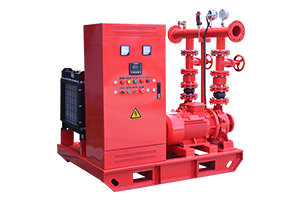May 07, 2024
Can fire pump sets be integrated with other building systems?
Yes, fire pump sets can be integrated with other building systems to enhance overall fire protection and building management capabilities. Integration with other systems allows for improved coordination, monitoring, and control, leading to more effective fire prevention, detection, and suppression. Some ways fire pump sets can be integrated with other building systems include:
1. Building Automation Systems (BAS): Fire pump sets can be connected to BAS, which monitors and controls various building systems, including HVAC, lighting, security, and fire protection. Integration with BAS enables centralized monitoring of fire pump performance, status alerts, and automatic responses to fire events.
2. Fire Alarm Systems: Fire pump sets are often integrated with fire alarm systems to ensure rapid response to fire incidents. When a fire alarm is triggered, the fire alarm system can activate the fire pump set to supply water to sprinkler systems or hydrants for fire suppression.
3. Emergency Power Systems: Fire pump sets may be connected to emergency power systems, such as generators or uninterruptible power supplies (UPS), to ensure continuous operation during power outages. This ensures that the fire pump set remains functional even when mains power is unavailable.
4. Water Supply Systems: Fire pump sets rely on water sources, such as municipal water supplies, water tanks, or reservoirs, to provide water for fire suppression. Integration with water supply systems ensures reliable water delivery to the fire pump set and enables automatic switching between water sources based on availability and demand.
5. Remote Monitoring and Control Systems: Fire pump sets can be integrated with remote monitoring and control systems, allowing facility managers to monitor pump performance, receive real-time alerts, and remotely control pump operation from any location with internet access.
6. Building Management Software (BMS): Integration with BMS platforms allows for centralized management of fire pump sets along with other building systems. BMS software provides advanced analytics, reporting, and scheduling capabilities, enabling proactive maintenance and optimization of fire protection systems.
By integrating fire pump sets with other building systems, facility managers can improve operational efficiency, enhance system reliability, and ensure compliance with fire safety regulations. Additionally, integration enables better coordination between fire protection systems and other building functions, contributing to overall safety and security.
.jpg) May 08, 2024What are the considerations for maintenance and servicing of fire pump sets in harsh environments?Maintaining and servicing fire pump sets in harsh environments requires careful attention to various factors to ensure their reliability and effectiveness. Here are some considerations:
May 08, 2024What are the considerations for maintenance and servicing of fire pump sets in harsh environments?Maintaining and servicing fire pump sets in harsh environments requires careful attention to various factors to ensure their reliability and effectiveness. Here are some considerations:.jpg) May 08, 2024What are the considerations for maintenance and servicing of fire pump sets in harsh environments?Maintaining and servicing fire pump sets in harsh environments requires careful attention to various factors to ensure their reliability and effectiveness. Here are some considerations:
May 08, 2024What are the considerations for maintenance and servicing of fire pump sets in harsh environments?Maintaining and servicing fire pump sets in harsh environments requires careful attention to various factors to ensure their reliability and effectiveness. Here are some considerations: May 07, 2024Can fire pump sets be integrated with other building systems?Yes, fire pump sets can be integrated with other building systems to enhance overall fire protection and building management capabilities. Integration with other systems allows for improved coordination, monitoring, and control, leading to more effective fire prevention, detection, and suppression. Some ways fire pump sets can be integrated with other building systems include:
May 07, 2024Can fire pump sets be integrated with other building systems?Yes, fire pump sets can be integrated with other building systems to enhance overall fire protection and building management capabilities. Integration with other systems allows for improved coordination, monitoring, and control, leading to more effective fire prevention, detection, and suppression. Some ways fire pump sets can be integrated with other building systems include: May 07, 2024What are the different types of fire pump drivers, and how do they differ?Fire pump drivers are crucial components in fire protection systems, providing the necessary power to drive fire pumps that supply water to sprinkler systems or hydrants for fire suppression. The main types of fire pump drivers include:
May 07, 2024What are the different types of fire pump drivers, and how do they differ?Fire pump drivers are crucial components in fire protection systems, providing the necessary power to drive fire pumps that supply water to sprinkler systems or hydrants for fire suppression. The main types of fire pump drivers include: May 06, 2024What are the backup power options for fire pump sets?Ensuring reliable backup power for fire pump sets is crucial for maintaining fire protection systems' effectiveness, especially during power outages or emergencies. Here are some common backup power options:
May 06, 2024What are the backup power options for fire pump sets?Ensuring reliable backup power for fire pump sets is crucial for maintaining fire protection systems' effectiveness, especially during power outages or emergencies. Here are some common backup power options: May 06, 2024What are the common issues or failures with fire pump sets?Fire pump sets are critical components of fire protection systems, so it's essential to be aware of potential issues or failures that may arise. Here are some common ones:
May 06, 2024What are the common issues or failures with fire pump sets?Fire pump sets are critical components of fire protection systems, so it's essential to be aware of potential issues or failures that may arise. Here are some common ones:





